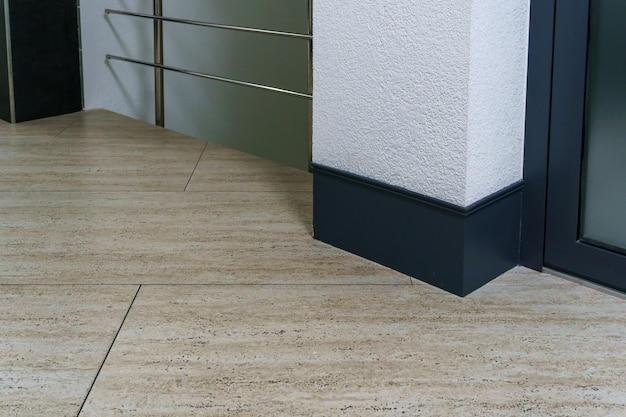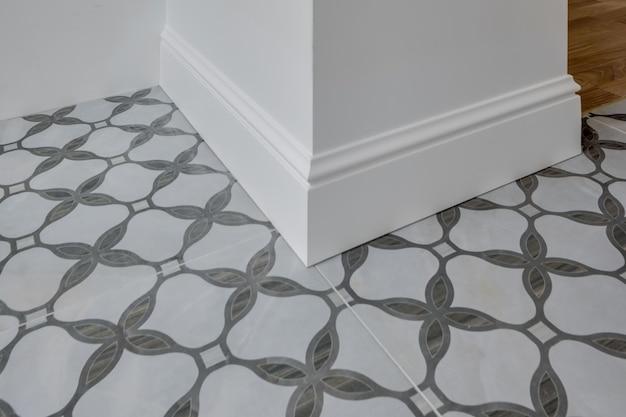Tiling a corner can be a challenging task, but with the right techniques and knowledge, you can achieve professional-looking results. Whether you’re tackling a shower renovation or a kitchen backsplash, understanding how to handle corners is crucial for a seamless finish. In this blog post, we will cover everything you need to know about tiling corners, addressing common questions such as whether to grout or silicone corners, how to finish outside and inside corners, where to start when tiling a wall, and much more.
If you’ve ever wondered about the best practices for tiling corners, this blog post is the ultimate resource for you. We’ll debunk myths, provide step-by-step instructions, and share expert tips to help you avoid common pitfalls. By the end, you’ll have the confidence and knowledge to flawlessly tile any corner in your next home improvement project. So, let’s dive in and discover the secrets to achieving picture-perfect corners with tiles!
How Do You Tile a Corner
When it comes to tiling a corner, things can get a little tricky. But fear not, my friend, for I am here to guide you through this perilous journey of perfectly placed tiles. So put on your DIY hat and let’s dive right into the art of tiling corners.
Start With a Proper Foundation
Before we even think about those beautiful tiles, we need to ensure our corner is ready for the makeover it deserves. Make sure the wall is clean, dry, and primed. Remember, a good foundation is key to a successful tiling project.
Measure Twice, Tile Once
Measuring is crucial, my fellow tiling enthusiast. Grab your tape measure and get those numbers down. Measure the height and width of your corner, accounting for any irregularities. This way, you’ll know exactly how many tiles you’ll need and how they’ll fit together like pieces of a puzzle.
Cut It Like a Pro
Ah, the dreaded cutting of tiles. But fret not, my friend, as I have a secret weapon for you: a wet saw. This trusty tool will help you achieve those precise cuts needed to tame those corner tiles. Just make sure to wear safety goggles and gloves because nothing ruins a tiling adventure like a trip to the ER.
It’s All About the Angle
Now, let’s get a little mathematical, shall we? When tiling a corner, you’ll need to create a 45-degree angle. This can be achieved by using a miter saw or a tile nipper. Whichever method you choose, remember to double-check those angles. We don’t want any wonky corners now, do we?
The Magic of Adhesive
Once your tiles are cut and ready to go, it’s time to bring out the magical adhesive. Apply a layer of thinset to the corner using a notched trowel. Don’t be stingy with the thinset; we want those tiles to stick like glue (well, technically it is glue, but you get the point).
Place Your Tiles with Care
Now comes the satisfying part – placing the tiles. Start from the bottom and work your way up, aligning each tile carefully with the ones below. Remember to leave a small gap between each tile for grout. And don’t forget to check for levelness as you go. We’re aiming for perfection here!
Grout It Up
Once the tiles have set in place, it’s time to unleash the power of grout. Mix it up according to the manufacturer’s instructions and spread it over your tiles, pressing it into the gaps with a grout float. Wipe off the excess grout with a damp sponge, and voila! Your tiles will be grinning from ear to ear.
Seal the Deal
To protect your hard work and ensure those tiles dazzle for years to come, finish off with a coat of penetrating tile sealer. This will help keep dirt and moisture at bay, because nobody likes a grimy corner.
And there you have it, my aspiring tile artist! You now possess the knowledge and know-how to tackle tiling corners like a pro. So go forth, unleash your creativity, and turn those corners into a thing of beauty. Happy tiling!
Note: This blog post is for informational purposes only and should not be taken as professional advice. Always consult a qualified professional before undertaking a tiling project.
FAQ: How Do You Tile A Corner
Can shower water leak through grout
You might be wondering if your carefully tiled corner will hold up against the onslaught of shower water. Fear not! When properly sealed and maintained, grout is designed to be waterproof and can prevent water leakage.
Do you grout or silicone corners
Ah, the great debate of grouting versus silicone! When it comes to corners, the general consensus is to silicone them. Silicone provides flexibility, allowing for movement that can occur in corners due to temperature changes or settling. So, when it comes to corners, silicone is your friend.
Can you start tiling in a corner
Yes, indeed! Starting your tiling project in a corner can provide a neat and seamless finish. Just make sure to plan and measure beforehand, ensuring that the tiles fit snugly without the need for awkward cuts.
How do you finish outside corners of tile
Outside corners can be a bit trickier to tackle, but fear not, we’ve got you covered! To create a polished and professional look, you can use various options such as corner trims, bullnose tiles, or even mitered cuts. It all depends on your personal preference and the style you’re aiming for.
How long leave grout before wiping
Patience, my friend! After applying grout, give it some time to set. The general rule of thumb is to wait for about 15-30 minutes before wiping away excess grout with a damp sponge. But remember, always follow the instructions provided by the specific grout manufacturer for the best results.
Where do you start when tiling a wall
When embarking on a wall tiling adventure, it’s usually best to start from the bottom and work your way up. This helps ensure a level and visually pleasing layout. Plus, it reduces the risk of having to make tricky, eye-straining cuts at eye level. Let’s keep it easy on those peepers!
Do you overlap tile corners
Overlap? Oh no, dear reader, that would be a disaster waiting to happen! Overlapping tile corners can create an unsightly and unstable mess. Instead, aim for a clean and precise finish by carefully aligning the edges of your tiles for a tight fit.
Do you grout inside corners
Absolutely! Grouting inside corners is essential for both aesthetics and durability. It helps keep those corners secure and prevents dirt and moisture from sneaking in. So go ahead and give those inside corners the love and attention they deserve.
How do you tile inside corners
Ah, the art of tiling inside corners. For a seamless and cohesive look, it’s best to use a technique called “butt jointing.” Simply align the edges of the tiles in the corner without any gap, creating a smooth transition. This technique requires precision and patience, but the end result is oh-so-satisfying.
Do you put adhesive on tile or wall
The eternal adhesive dilemma! When it comes to tiling, it’s common practice to apply adhesive to the wall using a notched trowel. This allows for a consistent application and helps prevent excess adhesive from oozing out between the tiles. So remember, adhesive on the wall, not the tile!
How do you not tile a corner
Sometimes, it’s not about what to do but rather what not to do. So, how do you avoid tiling a corner? Well, it’s simple, really! Just stop before you reach the corner. Leave it as an open space, or consider using corner trims or decorative elements to create a stylish finishing touch. Let’s embrace the beauty of negative space!
Should you grout shower corners
Ah, the grout dilemma strikes again! When it comes to shower corners, yes, you should definitely grout them. Grouting provides stability and prevents water from seeping in and causing damage. Plus, it keeps your shower looking fresh and clean. So don’t skimp on those corners!
Can you caulk over grout in shower corners
Oh, the joys of caulk and grout! If you notice any cracks or gaps in your shower corners, fear not! Caulk can come to the rescue. It’s perfectly acceptable to caulk over grout in shower corners to ensure a tight seal and keep moisture away. Just remember to choose a high-quality silicone caulk for the best results.
Do you grout or silicone shower corners
Ah, the never-ending debate! When it comes to shower corners, silicone is the way to go. It provides flexibility and prevents cracks, allowing for movement without compromising the seal. So leave the grout for the tile joints and let silicone take care of those corners like a trusty sidekick.
Should I grout shower floor before tiling walls
Timing is everything in life, and tiling is no exception. When tackling a shower project, it’s wise to tackle the floor first before moving on to the walls. This ensures that the walls are tiled over the floor tiles, creating a seamless and visually pleasing transition.
Do you put tile trim on before tiling
Timing is key, my friend! When it comes to tile trim, it’s generally best to install it after you have finished tiling. This allows for a clean and precise finish, ensuring that the tile trims sit flush against the tiles without any messy overhang. Plus, it gives you an opportunity to admire your handy tiling work before adding those finishing touches.
Do you grout between pencil tile
Ah, the delicate and stylish pencil tile! When it comes to grouting pencil tiles, it’s best to tread carefully. These narrow beauties are often not grouted to maintain their sleek and delicate appearance. Instead, you can use a clear silicone caulk to seal the edges and keep them looking sharp and refined.
Do you start tiling from the top or bottom
When it comes to tiling, let gravity be your guide! It’s generally recommended to start tiling from the bottom and work your way up. This way, you can ensure that the tiles in the lower rows are properly aligned and supported. Plus, it minimizes the risk of having tiles sliding down as you work your way up. Safety first, my friend!
And there you have it, a comprehensive FAQ-style guide to tiling corners! With these answers at your fingertips, you’ll be well-prepared to tackle any corner-related tiling challenge that comes your way. Happy tiling, dear reader!

